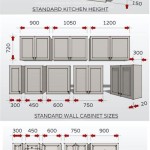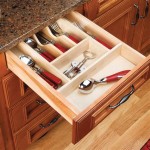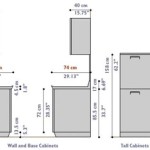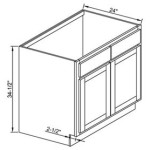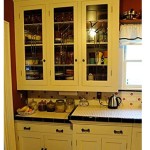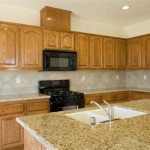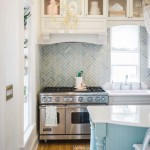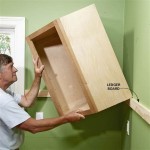Can You Mix Knobs and Pulls on Kitchen Cabinets?
The question of whether to mix knobs and pulls on kitchen cabinets is a common one during kitchen renovations or upgrades. The answer, generally, is yes, but with certain considerations to ensure the final result is aesthetically pleasing and functionally effective. The decision hinges on a variety of factors including the style of the kitchen, the size and placement of the cabinets and drawers, and the overall design aesthetic. Understanding the nuances of these factors is crucial for achieving a cohesive and stylish kitchen design.
Traditionally, kitchen designs adhered to stricter rules regarding hardware. Coordinated sets of knobs and pulls were the norm, ensuring a uniform and predictable look. However, modern design trends increasingly embrace eclecticism and personalization. Mixing knobs and pulls allows homeowners to express their individual style and create a more custom, less cookie-cutter kitchen environment.
While mixing is generally acceptable, it's essential to approach the process with careful planning. Randomly selecting different hardware styles can lead to a jarring and disjointed appearance. Thoughtful consideration of design principles such as balance, proportion, and consistency is paramount to achieving a successful outcome.
Understanding the Functionality of Knobs and Pulls
Before delving into design considerations, it's important to understand the functional differences between knobs and pulls. Knobs are typically smaller and require a single point of contact for opening cabinets and drawers. This makes them suitable for lighter-duty applications, such as upper cabinets or smaller drawers containing lighter items. Pulls, on the other hand, offer a larger surface area for gripping, providing more leverage. This makes them ideal for heavier drawers, lower cabinets, and appliances that require more effort to open.
The ergonomic aspect is a key factor. For individuals with arthritis or limited hand strength, pulls are generally easier to use than knobs. The ability to use the forearm for leverage, rather than just the fingertips, can make a significant difference in accessibility and comfort. Therefore, incorporating pulls on frequently used drawers or cabinets is a practical consideration.
Furthermore, the size and weight of the drawer or door play a critical role. Large, heavy drawers laden with pots and pans will benefit from the added leverage provided by pulls. Conversely, smaller, lighter drawers containing utensils or spices may function perfectly well with knobs.
Consider the location of the cabinets and drawers as well. Cabinets under a sink or cooktop often benefit from pulls because these areas are frequently accessed with wet or greasy hands. A pull provides a more secure grip in these situations.
Key Design Considerations for Mixing Hardware
When mixing knobs and pulls, several design considerations should be taken into account to ensure a harmonious and balanced look. Consistency in finish, style, and scale are essential. The goal is to create a cohesive design that feels intentional, rather than haphazard.
Finish: Maintaining a consistent finish is often the easiest way to tie different hardware styles together. Whether it's brushed nickel, oil-rubbed bronze, matte black, or polished chrome, sticking to a single finish creates a sense of unity. Avoid mixing warm and cool-toned finishes unless it is a deliberate design choice and carefully executed. For example, pairing brushed brass with matte black can work well in a modern farmhouse setting, but it requires a keen eye for detail.
Style: While mixing distinct styles can be tempting, it's generally best to keep the hardware within a similar design family. For example, pairing sleek, modern knobs with minimalist pulls is a safe bet. However, pairing ornate, vintage knobs with contemporary bar pulls might create a clash. Consider the overall style of your kitchen – contemporary, traditional, farmhouse, etc. – and select hardware that complements that aesthetic.
Scale: The size of the hardware should be proportionate to the size of the cabinets and drawers. Small knobs on large drawers will look inadequate, while oversized pulls on small cabinets can appear overwhelming. Consider the visual weight of each piece and ensure that they are appropriately scaled to their surroundings. As a general rule, drawer pulls should be approximately one-third the width of the drawer.
Placement: Strategic placement of knobs and pulls is crucial for achieving a balanced look. A common approach is to use knobs on upper cabinets and pulls on lower cabinets and drawers. This visually grounds the design and provides practical functionality. Another option is to use knobs on all doors and pulls on all drawers. This creates a consistent pattern that is both easy to understand and aesthetically pleasing.
Consider the visual lines created by the hardware. Aligning the hardware vertically or horizontally can create a sense of order and cohesion. For example, aligning all pulls along the top edge of drawers or centering knobs on cabinet doors can create a clean and unified aesthetic.
Pattern: Establishing a pattern or rhythm can help create a sense of visual interest. For example, using knobs on all upper cabinets and pulls on all lower cabinets establishes a clear and consistent pattern. Another option is to alternate knobs and pulls on a row of drawers, creating a more playful and dynamic look. However, ensure that the pattern is consistent and well-defined to avoid a haphazard appearance.
Testing and Mock-ups: Before committing to a particular hardware combination, it's helpful to test it out. Purchase a few samples of each knob and pull and hold them up to your cabinets and drawers to get a sense of how they look together. Consider creating a mock-up by attaching the hardware to a piece of cardboard that is the same size as your cabinet doors and drawers. This will allow you to visualize the final result and make adjustments as needed.
Specific Applications and Considerations
Certain kitchen features require specific hardware considerations. Islands, pantries, and specialty cabinets may benefit from unique hardware choices that enhance their functionality and aesthetics.
Kitchen Islands: Islands often serve as focal points in the kitchen, so their hardware should be carefully considered. If the island has both cabinets and drawers, mixing knobs and pulls can be a stylish choice. Consider using larger, more substantial pulls on the island drawers to create a visual statement. Alternatively, using a consistent hardware style throughout the island can create a more minimalist and unified look.
Pantry Cabinets: Pantry cabinets are typically tall and require easy access to stored items. Pulls are generally a better choice for pantry cabinets, as they provide a more secure grip and easier access to items at different heights. Consider using longer pulls on pantry doors to maximize leverage and accessibility.
Specialty Cabinets: Specialty cabinets, such as spice racks, pull-out shelves, or appliance garages, may require specific hardware considerations. Knobs may be suitable for smaller, lighter specialty cabinets, while pulls are generally a better choice for larger, heavier ones. Consider the weight and frequency of use when selecting hardware for specialty cabinets.
Appliance Hardware: Integrating appliances with cabinetry requires careful consideration of hardware. Appliance pulls are specifically designed to withstand the weight and use of appliances such as refrigerators and dishwashers. These pulls are typically larger and more robust than standard cabinet pulls, and they should be selected to complement the overall kitchen design.
Ultimately, the decision of whether to mix knobs and pulls on kitchen cabinets is a personal one. By carefully considering the functional differences between knobs and pulls, the design principles of balance, proportion, and consistency, and the specific requirements of different kitchen features, homeowners can create a kitchen that is both stylish and functional.
Paying attention to the details of hardware selection can significantly impact the overall aesthetic and usability of a kitchen. Thoughtful planning and execution are key to achieving a cohesive and visually appealing design.

How To Mix And Match Your Kitchen Cabinet Hardware

Top Tips For Mixing And Matching Kitchen Cabinet Hardware

How To Mix And Match Your Kitchen Cabinet Hardware

How To Mix And Match Your Kitchen Cabinet Hardware

How To Mix And Match Your Kitchen Cabinet Hardware

How To Mix Match Kitchen Hardware Finishes Styles The Inspired Room

How To Mix Match Kitchen Hardware Finishes Styles The Inspired Room

How To Mix And Match Cabinet Hardware Sprucing Up Mamahood

How To Mix Cabinet Hardware Mockett

3 Tips For Mixing Knobs Pulls On Kitchen Cabinets
Related Posts

